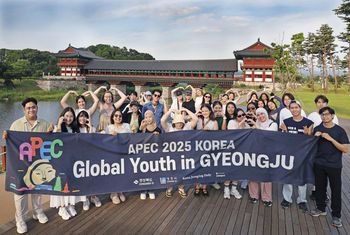A day in Gyeongju, heart of ancient Korea

Gyeongju: A City Where History Lives
Gyeongju, a city in North Gyeongsang Province, is often referred to as the “museum without walls.” This title is well-earned, as it houses an impressive collection of historical sites and artifacts that span centuries. From royal tombs and ancient observatories to Buddhist temples, Gyeongju showcases the rich cultural heritage of the Silla Dynasty, which ruled from 57 B.C. to A.D. 935. The city is home to more UNESCO-designated cultural heritage sites than any other in Korea, making it a must-visit destination for history enthusiasts.
Exploring Gyeongju's Cultural Heritage
One of the most notable attractions in Gyeongju is Bulguksa Temple, a UNESCO World Heritage Site that exemplifies the architectural and artistic achievements of the Silla Kingdom. The temple’s intricate design and stunning carvings reflect the deep influence of Buddhism on the region. During a recent tour organized by K-campus, a platform offering insights into Korean campus life, international students had the opportunity to explore this historic site and learn about its significance.
The tour also included visits to the Daereungwon Tomb Complex, a park-like area featuring over 20 ancient tombs of Silla royalty. Among these, the Cheonmachong tomb stands out due to the numerous treasures discovered within it, including gold crowns, belts, and accessories. These artifacts provide valuable insights into the burial practices and beliefs of the Silla people, who believed that gold would grant the deceased eternal peace and nobility in the afterlife.
Another highlight of the tour was Cheomseongdae, the oldest existing astronomical observatory in East Asia. Built during the reign of Queen Seondeok, the first queen in Korean history, this structure played a crucial role in measuring and recording celestial movements. Its presence underscores the advanced scientific knowledge of the Silla Kingdom.
A Blend of Past and Present
In addition to its historical sites, Gyeongju offers a vibrant modern atmosphere. Hwangnidan Street, located near many of the city’s historical landmarks, is lined with traditional Korean buildings known as hanok. These structures, built in the 1960s and 1970s, now serve as souvenir shops, cafes, and restaurants, attracting both locals and tourists. The blend of old and new makes Gyeongju a unique destination where visitors can experience both the past and present.
During their visit, students were particularly impressed by the seamless integration of history and modernity. French student Saliou Lea-Sara remarked on how the city’s historical sites coexisted with contemporary areas, creating a sense of continuity between the past and present. Argentine student Alfaro Maria Augustina also expressed admiration for the way Gyeongju preserved its cultural heritage while embracing modern developments.
The Gyeongju National Museum
As part of the tour, students visited the Gyeongju National Museum, which houses a vast collection of artifacts from the Silla Dynasty. The museum features Buddhist sculptures, items from Donggung, and gold crowns and ornaments from royal tombs, highlighting why Silla was known as the “Kingdom of Gold.” The exhibition showcases the exceptional craftsmanship and cultural achievements of the era, offering a comprehensive overview of the region’s history.
Reflections on Gyeongju
The tour concluded with a visit to Woljeonggyo Bridge, which connects the royal palace of Wolseong with Mount Namsan. This historic bridge served as a venue for royal ceremonies and cultural events, further emphasizing Gyeongju’s role as a center of power and tradition. Students were captivated by the bridge’s beauty and the stories it holds.
Indonesian student Bejahda Pujianti praised the efforts made to preserve Gyeongju’s heritage, noting that the city’s museums and historical sites offer a glimpse into the past. Turkish student Demirkaya Merve Sultan echoed this sentiment, expressing admiration for the way records were kept and used to restore historical landmarks like Woljeonggyo Bridge.
Despite some challenges, such as weather conditions that led to the omission of certain sites like Donggung and Gyochon Traditional Village, the tour provided a meaningful experience for all participants. It highlighted not only the richness of Gyeongju’s history but also the city’s commitment to preserving and showcasing its cultural legacy.
Post a Comment for "A day in Gyeongju, heart of ancient Korea"
Post a Comment